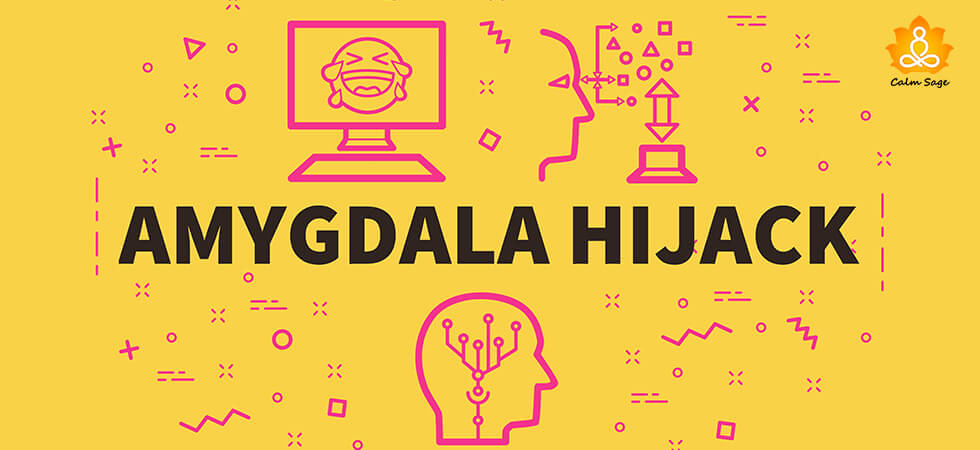Amygdala Hijack: Symptoms, Causes, and Prevention

Amygdala hijack is a kind of emotional response that our body generates when we are in stress.it is something that most people are unaware of. Sometimes we are doing our thing and suddenly there is an emotional outburst for no reason.
Well, that can be because your amygdala was hijacked by your emotions. What I always wondered was what can be the causes of amygdala hijack. I was unaware that the brain can also mess up in this way too.
If you are perplexed too just like I was, don’t you worry! Here are the answers to all your questions about amygdala hijacking. What can be the potential cause? What do the symptoms of amygdala hijack look like? And finally how can you prevent them from happening?
Let’s get started….
What Is An Amygdala Hijack?
The term amygdala hijack was coined by a psychologist named Daniel Goleman. While he was researching emotional intelligence, he found out that some people have an emotional overreaction to stressful situations. He then named it amygdala hijack.
Amygdala hijack is when our emotions over power us. It mostly happens because of stress. When our body is in extreme stress, our emotions are let loose and they end up hijacking the amygdala.
That is the reason people might behave differently (emotion wise) when they undergo a stressful situation. Some might laugh for no reason or cry unstoppably. There can be anger outburst or violence as well.
Basically because our emotions hijack the amygdala and the amygdala hijacks the frontal lobe, it’s functions are all disabled. Amygdala is responsible for the regulation of emotions. And when you are extremely stressed the amygdala loses its power to control the emotion.
What Can Cause An Amygdala Hijack?
The main cause of amygdala hijack is stress. The entire concept of amygdala hijack is an emotional response of stress. To better understand amygdala hijack you will have to first understand some parts of the brain and what role they play in emotional regulation.
- Amygdala: amygdala regulates our emotions. Another very important thing that it does is that it attached memories to emotions, known as emotional remembrance. It is located in the limbic system.
- Limbic system: the limbic system is responsible for our emotional as well as behavioral response to all kinds of situations.
- Frontal lobe: Frontal lobe is responsible for thinking, reasoning, decision making and planning. Frontal lobe controls the fright and flight response. It only let’s it active once it has evaluated the danger unlike amygdala.
These parts of the brain all manage and regulate our emotions. But what causes an amygdala hijack? Amygdala is responsible for the activation of fright and flight response. Frontal lobe then evaluates the danger and only if it is really dangerous it sends a signal to escape or fight the danger.
When we are in stress, the amygdala is taken over by our emotions, it’s emotional regulation is disabled but it can still activate the fright and flight response. At the same time the amygdala disables the functions of the frontal lobe.
Therefore, there is no evaluation of the threat and your body comes in a fright and flight for no actual physical danger.
What Do The Symptoms Of Amygdala Hijack Look Like?
Most of the symptoms of amygdala hijack are very similar to the symptoms of adrenaline rush. When you experience an amygdala hijack there is a chemical response to stress which result in:
- Excessive release of cortisol and adrenaline all together
- Inappropriate behavior
- Irritability
- Increased blood pressure
- Expanded airways
- Goosebumps
- Rapid increase in blood sugar
- Dilated pupils
- Sweat on palms
- Clammy skin
How Can You Stop An Amygdala Hijack?
If you are worried about how you can stop this from happening, here’s the answer! Since it is an automated response it’s not really your fault. But there is a way out. Amygdala’s fright and flight response has to be deactivated and the reasoning from the frontal lobe has to be activated.
While your fright and flight response is heightened you can’t really do anything but observe. Make notes of what is really triggering you. What can be an alternate response to these triggers and how you can control your emotions.
This is the only way you can activate your frontal lobe. Therefore they should be self-aware of what you are feeling and why you may be feeling that way. And then plan a more calm reaction to your trigger points.
Also read: 15+ Effective Stress-Relievers For A Positive Life
Another thing that you can try while you are experiencing an amygdala hijack is breathing exercises. A good breathwork can really help you re-activated the frontal lobe so that the evaluation of threat and danger can begin.
Endnote…
Amygdala hijack is basically when you lose control over your emotions as well as your power to reason. The amygdala hijacks the frontal lobe which makes it very difficult for us to reason with our reaction and evaluate the situation so that we can plan our response.
I hope this blog helps you understand amygdala hijacking and its cause and symptoms. Now that you know how to stop an amygdala hijack, I hope it’s easier for you to come back to a normal state of mind after facing a stressful situation.
Thanks for reading.
Take care and stay safe.




















